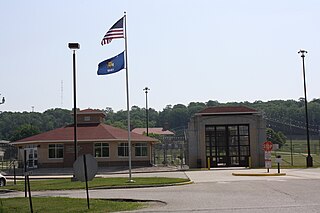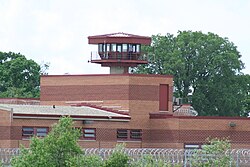
Christopher J. Scarver Sr. is an American convicted murderer. He is best known for the 1994 murders of his fellow inmates Jeffrey Dahmer and Jesse Anderson, both convicted murderers, at the Columbia Correctional Institution in Wisconsin. The three inmates were on a work detail together in the prison gymnasium, and had a confrontation while unsupervised. Scarver had concealed a metal bar that he used to beat and fatally injure Dahmer and Anderson. Scarver was convicted and sentenced to two further life sentences for these murders. He had already been sentenced to life in prison after being convicted of the murder of Steve Lohman in 1990.

Minnesota Correctional Facility – Oak Park Heights (MCF-OPH) is Minnesota's only Level Five maximum security prison. The facility is located near the cities of Bayport and Stillwater. The facility is designed and employed with trained security officers to handle not only Minnesota's high-risk inmates but other states' as well. They also have the largest contract to house federal inmates with serious, violent histories. The prison has never had an escape, and only one homicide.

The Federal Correctional Institution, Leavenworth is a medium-security federal prison for male inmates in northeast Kansas. It is operated by the Federal Bureau of Prisons, a division of the United States Department of Justice. It also includes a satellite federal prison camp (FPC) for minimum-security male offenders.

A super-maximum security (supermax) or administrative maximum (ADX) prison is a "control-unit" prison, or a unit within prisons, which represents the most secure level of custody in the prison systems of certain countries.
Millhaven Institution is a maximum security prison located in Bath, Ontario. Approximately 500 inmates are incarcerated at Millhaven.

The Federal Correctional Institution, Thomson, formerly United States Penitentiary, Thomson and Thomson Correctional Center, is a low-security federal prison located in Thomson, Illinois. It has an area of about 146 acres (59 ha) and comprises 15 buildings. The facility is enclosed by a 15-foot (4.6 m), 7000 volt electric fence surrounded by an additional 12-foot (3.7 m) exterior fence covered with razor wire. Thomson has eight cellhouses with a rated capacity of 2,100 beds—1,900 high-security SMU beds and 200 minimum-security beds at the onsite camp—and according to BOP officials, the potential to use some of its high-security rated capacity to house up to 400 ADX inmates. From its completion in 2001 to 2006, it remained empty. By 2009, only the minimum-security section housed prisoners.
The Ohio State Penitentiary (OSP) is a 502-inmate capacity supermax Ohio Department of Rehabilitation and Correction prison in Youngstown, Ohio, United States.

William C. Holman Correctional Facility is an Alabama Department of Corrections prison located in Atmore, Alabama. The facility is along Alabama State Highway 21.

The Federal Correctional Institution, Dublin was a low-security United States federal prison for female inmates in Dublin, California. The facility also has an adjacent satellite prison camp housing minimum-security female offenders.

Jesse Michael Anderson was an American criminal. Anderson was convicted of the murder of his wife, Barbara Anderson, and in attempting to escape blame for the murder, he wounded himself and claimed to police that the couple had been attacked by two black men.
Mountain Institution is a medium security federal penitentiary operated by the Correctional Service of Canada (CSC). It is located in the town of Agassiz, District of Kent, British Columbia, approximately 115 kilometres east of Vancouver, British Columbia.

The Massachusetts Correctional Institution at Concord (MCI-Concord) was a medium security prison for men located in Concord, Massachusetts in the United States. Opened in 1878, it was the oldest running state prison for men in Massachusetts. It was under the jurisdiction of the Massachusetts Department of Correction. The facility had a total capacity of 614 general population beds, but with a long-term decline in the number of men incarcerated for the entire state, the population as of January 2024 had decreased to about 300, which made Governor Maura Healey announce a plan to close the prison in the summer of that year and transfer the remaining prisoners to other facilities.

California Substance Abuse Treatment Facility and State Prison, Corcoran (SATF) is a male-only state prison located in the city of Corcoran, in Kings County, California, specifically designed to house inmates who have substance use disorder. It is sometimes referred to as California Substance Abuse Treatment Facility, and Corcoran II.

California Correctional Institution (CCI) is a supermax state prison in the city of Tehachapi in Southern California. CCI is sometimes referred to as "Tehachapi prison" or "Tehachapi". As stated by the California Department of Corrections and Rehabilitation, its overall mission is "to incarcerate and control felons, while providing the opportunity for meaningful work, training and other programs. The prison provides programs for those inmates who are willing to work and participate fully in available programs."
Chillicothe Correction Institution, or CCI, is a state-run medium security prison on the west bank of the Scioto River just outside Chillicothe, Ohio. It is located adjacent to Ross Correctional Institution and Hopewell Culture National Historical Park. The prison is a former military camp, named for Civil War general William Tecumseh Sherman. It later became a federal penitentiary and has housed several high-profile prisoners including Charles Manson in 1952, bootlegger and future NASCAR driver Junior Johnson, and serial killer Anthony Sowell.

Taycheedah Correctional Institution is a prison in Fond du Lac, Wisconsin near the Town of Taycheedah. Established in 1921, it was known as Wisconsin Home for Women until 1975. The facility houses maximum-security and medium-security adult females, with an average population of 936 as of May 2019.

The Union Correctional Institution, formerly referred to as Florida State Prison, and also commonly known as Raiford Prison is a Florida Department of Corrections state prison located in unincorporated Union County, Florida, near Raiford.

Dodge Correctional Institution(DCI) is an adult male maximum-security correctional facility operated by the Wisconsin Department of Corrections Division of Adult Institutions in Waupun, Wisconsin, US. The facility was converted from the Central State Hospital for the Criminally Insane to an adult correctional facility in 1977 at a cost of $2.47 million of general obligation bonds, as authorized by Chapter 29 of the Laws of 1977. The first two inmates were transferred from the nearby Waupun Correctional Institution to DCI on May 15, 1978. On October 29, 1993, ground was broken for a $45 million expansion which more than doubled the size of the facility. On June 17, 1996, the first female prisoner was admitted to DCI making it the only reception center for both male and female adult felons committed to the Wisconsin Department of Corrections. DCI served as the reception center for both male and female inmates until December 1, 2004, when the female reception center moved to the Taycheedah Correctional Institution. DCI also serves as the central medical center for the division, providing both in-patient and out-patient care for male and female inmates.

North Carolina Correctional Institution for Women (NCCIW) is the primary North Carolina Department of Public Safety prison facility housing female inmates on a 30-acre (12 ha) campus in Raleigh, North Carolina, and serves as a support facility for the six other women's prisons throughout the state. The facility's inmate population, which is the largest in the state, consists of inmates from all custody levels and control statuses including death row, maximum security, close custody, medium security, minimum security, and safekeepers.
Washington Corrections Center for Women is a Washington State Department of Corrections women's prison located in unincorporated Pierce County, Washington, with a Gig Harbor address. With an operating capacity of 740, it is the largest women's prison in the state and is surrounded by Washington State Route 16, and McCormick forest park. It opened 54 years ago in 1971, 82 years after statehood.

















